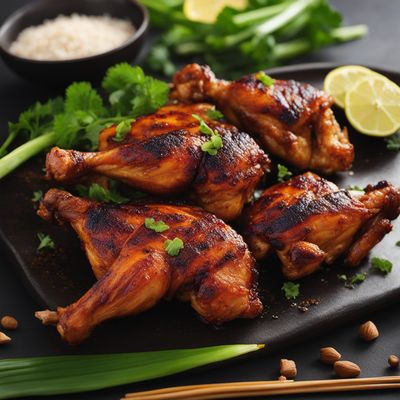
Recipe
Chinese Buddhist Es Teler
Zen Delight: Chinese Buddhist Es Teler
4.5 out of 5
Indulge in the harmonious blend of flavors and textures with this Chinese Buddhist adaptation of the traditional Indonesian Es Teler. This refreshing dessert embodies the principles of Chinese Buddhist cuisine while retaining the essence of the original dish.
Metadata
Preparation time
15 minutes
Cooking time
5 minutes
Total time
20 minutes
Yields
4 servings
Preparation difficulty
Easy
Suitable for
Vegetarian, Vegan, Gluten-free, Dairy-free, Nut-free
Allergens
N/A
Not suitable for
Paleo, Keto, Low-carb, High-protein, Atkins
Ingredients
In this Chinese Buddhist adaptation of Es Teler, we replace the traditional sweetened condensed milk with coconut milk to align with the principles of Chinese Buddhist cuisine. Additionally, we incorporate pandan leaves for their aromatic essence, which is commonly used in Chinese desserts. The choice of fruits remains similar, focusing on tropical fruits that are readily available in both Indonesian and Chinese cuisines. We alse have the original recipe for Es teler, so you can check it out.
-
2 cups (470ml) coconut milk 2 cups (470ml) coconut milk
-
1/4 cup (60ml) pandan juice 1/4 cup (60ml) pandan juice
-
1/2 cup (100g) palm sugar, grated 1/2 cup (100g) palm sugar, grated
-
1 cup (150g) jackfruit, sliced 1 cup (150g) jackfruit, sliced
-
1 ripe avocado, diced 1 ripe avocado, diced
-
1 cup (150g) lychee, peeled and deseeded 1 cup (150g) lychee, peeled and deseeded
-
1/4 cup (30g) toasted sesame seeds 1/4 cup (30g) toasted sesame seeds
-
1/4 cup (30g) peanuts, crushed 1/4 cup (30g) peanuts, crushed
-
Ice cubes, as needed Ice cubes, as needed
Nutrition
- Calories (kcal / KJ): 320 kcal / 1340 KJ
- Fat (total, saturated): 20g, 16g
- Carbohydrates (total, sugars): 32g, 20g
- Protein: 4g
- Fiber: 3g
- Salt: 0.02g
Preparation
-
1.In a saucepan, heat the coconut milk over medium heat until it starts to simmer.
-
2.Add the pandan juice and grated palm sugar to the coconut milk, stirring until the sugar is fully dissolved. Remove from heat and let it cool.
-
3.In serving glasses or bowls, layer the sliced jackfruit, diced avocado, and peeled lychee.
-
4.Pour the cooled coconut milk mixture over the fruits.
-
5.Add a handful of ice cubes to each glass or bowl.
-
6.Sprinkle toasted sesame seeds and crushed peanuts on top.
-
7.Serve immediately and enjoy the refreshing Chinese Buddhist Es Teler.
Treat your ingredients with care...
- Pandan leaves — If fresh pandan leaves are not available, you can use pandan extract or essence as a substitute. Adjust the quantity according to the strength of the flavor.
- Jackfruit — Use ripe jackfruit for its sweet taste and soft texture. Canned jackfruit can also be used if fresh jackfruit is not available.
- Palm sugar — If palm sugar is not accessible, you can substitute it with brown sugar or coconut sugar.
Tips & Tricks
- For an extra refreshing twist, chill the coconut milk mixture in the refrigerator before pouring it over the fruits.
- Experiment with different combinations of tropical fruits such as mango, pineapple, or dragon fruit to add variety to your Chinese Buddhist Es Teler.
- To enhance the nutty flavor, lightly toast the sesame seeds and peanuts before sprinkling them on top of the dessert.
Serving advice
Serve Chinese Buddhist Es Teler chilled to fully enjoy its refreshing taste. It can be served as a dessert after a Chinese Buddhist meal or as a standalone treat during hot summer days.
Presentation advice
Present the Chinese Buddhist Es Teler in clear glass bowls or glasses to showcase the vibrant colors of the fruits and the creamy coconut milk. Garnish with a pandan leaf for an elegant touch.
More recipes...
For Es teler
For Indonesian cuisine » Browse all
More Indonesian cuisine dishes » Browse all

Rujak soto
Rujak Soto
Rujak soto is a traditional Indonesian salad that is perfect for a light lunch or dinner. It is made with fresh fruits and vegetables, and a spicy...

Sate kambing
Lamb Satay
Sate kambing is an Indonesian dish that is made with grilled lamb skewers and a spicy peanut sauce.

Semur
Beef stew
Semur is a traditional Indonesian stew that is slow-cooked with meat, vegetables, and spices. The dish is known for its rich and flavorful sauce...








